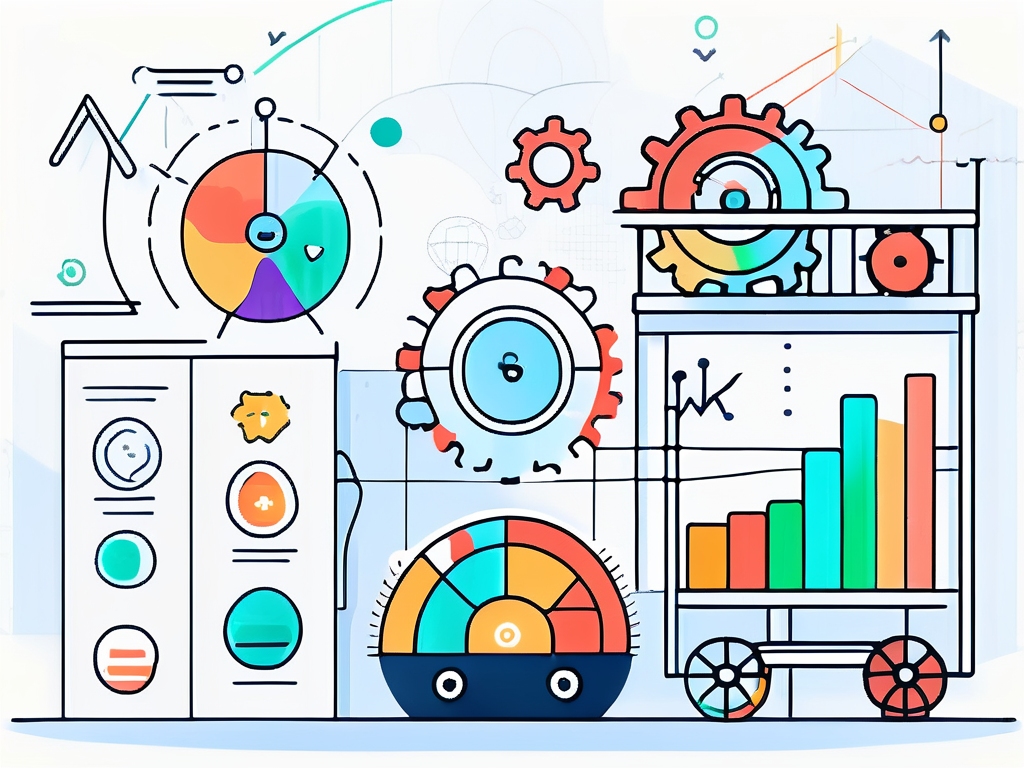In today’s competitive childcare industry, it is crucial for childcare centers to effectively measure their success and streamline their operations. One effective way to achieve this is through KPI tracking. By understanding and implementing Key Performance Indicators (KPIs), childcare centers can monitor their performance, identify areas for improvement, and make data-driven decisions to enhance their overall operations. This article will explore the importance of KPIs in childcare, identify relevant KPIs for different aspects of childcare management, and provide guidelines for implementing and utilizing KPI tracking effectively.
Understanding the Importance of KPIs in Childcare
Key Performance Indicators (KPIs) are measurable values that indicate how well an organization is achieving its goals. In the childcare industry, KPIs play a vital role in monitoring and measuring the success of various aspects of childcare operations. They provide valuable insights into areas such as staff performance, operations efficiency, child safety, and overall quality of care.
Tracking KPIs in childcare is not just about numbers; it’s about ensuring that every child receives the best possible care and support. By analyzing KPIs, childcare providers can identify trends, patterns, and areas of improvement to enhance the overall experience for both children and parents. This data-driven approach allows for informed decision-making and continuous enhancement of services.
Defining Key Performance Indicators (KPIs)
KPIs in childcare can be broadly categorized into quantitative and qualitative metrics. Quantitative KPIs are easily measurable and include indicators such as enrollment numbers, attendance rates, revenue, and expenses. Qualitative KPIs, on the other hand, focus on the quality of care and include indicators such as parent satisfaction, staff turnover rates, and child development milestones.
Quantitative KPIs provide a snapshot of the center’s financial health and operational efficiency, while qualitative KPIs offer insights into the emotional well-being and developmental progress of the children in care. Balancing both types of KPIs is essential for a holistic evaluation of a childcare center’s performance.
The Role of KPIs in Childcare Management
KPIs serve as a valuable tool for childcare management by providing a clear picture of the center’s performance. They enable managers to set performance benchmarks, monitor progress towards goals, and identify areas for improvement. Moreover, KPIs help measure the impact of strategic decisions, identify potential risks, and allow for proactive intervention when necessary.
Effective KPI management in childcare involves regular monitoring, analysis, and adaptation. By leveraging KPI data, childcare managers can make informed decisions to optimize resources, enhance staff training programs, and improve the overall quality of care provided to children. Ultimately, KPIs empower childcare centers to strive for excellence and continuously raise the standard of care in the industry.
Schedule a free 30-minutes session with us
Identifying Relevant KPIs for Childcare
When it comes to childcare, not all KPIs are created equal. It is essential to identify and track the right metrics that align with the center’s goals and objectives. Let’s explore some key areas where KPIs can be applied:

Childcare centers play a crucial role in the development and well-being of children. Monitoring and evaluating key performance indicators (KPIs) can help centers ensure they are providing high-quality care and meeting the needs of both children and parents. By focusing on specific areas of operation, childcare centers can track their performance and make data-driven decisions to improve their services.
KPIs for Childcare Staff Performance
Effective staff performance is crucial for delivering high-quality childcare services. KPIs in this area might include indicators such as staff-to-child ratios, staff qualifications and certifications, staff attendance and punctuality rates, and parent feedback on staff professionalism and communication. By tracking these metrics, childcare centers can ensure that their staff members are well-equipped to provide a safe and nurturing environment for children.
Additionally, staff training and development programs can be evaluated based on KPIs related to ongoing education and skill enhancement. By investing in staff training, childcare centers can improve the overall quality of care provided to children and enhance employee satisfaction and retention.
KPIs for Childcare Operations
Efficient operations are vital for delivering seamless childcare services. KPIs in this area might include indicators such as enrollment rates, waitlist numbers, program utilization rates, staff productivity, and facility maintenance costs. By monitoring these KPIs, childcare centers can optimize their operations, streamline processes, and ensure that resources are allocated effectively to meet the needs of children and families.
Moreover, tracking KPIs related to customer satisfaction and retention can provide valuable insights into the quality of services offered by the childcare center. By soliciting feedback from parents and caregivers, childcare centers can identify areas for improvement and implement strategies to enhance the overall customer experience.
KPIs for Child Safety and Well-being
Child safety and well-being are top priorities for any childcare center. KPIs in this area might include indicators such as incident and accident rates, health and hygiene compliance, child illness rates, and parent feedback on safety measures. By prioritizing these KPIs, childcare centers can create a secure and healthy environment for children to learn and grow.
Furthermore, implementing comprehensive safety protocols and emergency preparedness plans can help childcare centers mitigate risks and respond effectively to any unforeseen situations. By regularly reviewing and updating safety KPIs, centers can demonstrate their commitment to providing a safe and nurturing space for children under their care.
Implementing KPI Tracking in Your Childcare Center
Once the relevant KPIs have been identified, it is essential to implement an effective KPI tracking system to monitor and measure performance accurately. Here are some key considerations:

Tracking KPIs in a childcare center can provide valuable insights into various aspects of operations, including enrollment numbers, staff performance, and child development outcomes. By implementing a robust KPI tracking system, childcare center administrators can make data-driven decisions to improve overall quality and efficiency.
Choosing the Right KPI Tracking Tools
There are numerous KPI tracking tools available, ranging from simple spreadsheet-based systems to more advanced software solutions. Choose a tool that aligns with the center’s needs, offers real-time data tracking and reporting capabilities, and provides a user-friendly interface for easy data entry and analysis. Consider factors such as scalability, integration with existing systems, and customization options when selecting the most suitable KPI tracking tool for your childcare center.
Some advanced KPI tracking tools offer features such as automated data collection, customizable dashboards, and predictive analytics, allowing childcare center managers to gain deeper insights into performance metrics and trends. Investing in a comprehensive KPI tracking tool can streamline data management processes and facilitate informed decision-making.
Training Staff on KPI Tracking
To ensure effective KPI tracking, it is crucial to train staff on the importance of KPIs, how to collect relevant data, and how to use the tracking tools effectively. This training should be ongoing, with regular refresher sessions to ensure staff buy-in and consistent data input. Encouraging a culture of data literacy and accountability among staff members can enhance the accuracy and reliability of KPI tracking in the childcare center.
Regularly Reviewing and Updating Your KPIs
KPIs should not be set in stone. As the childcare industry and your center’s needs evolve, it is essential to review and update the KPIs to ensure they remain relevant and reflective of your goals. Regularly analyze the tracked data, identify trends, and make adjustments to your KPIs as necessary. Engage key stakeholders in the review process to gather diverse perspectives and ensure that the KPIs align with the strategic objectives of the childcare center.
By continuously refining and updating KPIs based on data insights and industry best practices, childcare centers can adapt to changing circumstances and drive continuous improvement in service delivery and outcomes for children and families.
Schedule a free 30-minutes session with us
Using KPIs to Improve Childcare Operations
KPI tracking is not just about collecting data; it is about using that data to drive positive change and improvement. Let’s explore some ways KPIs can be leveraged to enhance childcare operations:

Streamlining Administrative Processes with KPIs
By tracking KPIs related to administrative processes, such as enrollment and attendance, childcare centers can identify bottlenecks, streamline workflows, and implement more efficient systems. This, in turn, enhances the overall experience for both staff and parents.
For example, by closely monitoring enrollment KPIs, childcare centers can identify periods of high demand and plan accordingly. They can allocate resources and staff in a way that ensures smooth enrollment processes, minimizing wait times for parents and ensuring that children can start their childcare journey without delay. Additionally, tracking attendance KPIs allows centers to identify patterns and address any issues promptly. For instance, if there is a consistent drop in attendance for a particular age group, the center can investigate the underlying reasons and take appropriate action, such as adjusting schedules or implementing engaging activities to increase attendance.
Enhancing Childcare Quality through KPI Analysis
KPIs related to childcare quality, such as parent satisfaction and child development milestones, provide valuable insights into areas that require improvement. By analyzing these KPIs, childcare centers can implement targeted training programs, review curriculum effectiveness, and enhance the overall quality of care provided.
For instance, by tracking parent satisfaction KPIs through surveys or feedback forms, childcare centers can gain a deeper understanding of the aspects that parents appreciate and areas where improvements can be made. This feedback can then be used to develop training programs for staff, ensuring that they have the necessary skills and knowledge to provide exceptional care. Additionally, tracking child development milestones allows centers to assess the effectiveness of their curriculum and make adjustments if needed. By aligning their programs with the latest research and best practices, childcare centers can ensure that children receive the highest quality of care and support their optimal growth and development.
Leveraging KPIs for Strategic Decision Making
KPI tracking enables childcare center managers to make data-driven decisions. By regularly reviewing and analyzing KPIs, managers can identify areas of strength and weakness, allocate resources effectively, set goals, and make informed strategic decisions that contribute to the overall success of the center.
For example, by tracking KPIs related to staff performance and child-to-staff ratios, managers can identify areas where additional training or support may be needed. They can allocate resources to provide ongoing professional development opportunities, ensuring that staff members have the necessary skills and knowledge to deliver high-quality care. Additionally, by analyzing KPIs related to occupancy rates and revenue, managers can make informed decisions about expanding capacity, adjusting pricing, or implementing marketing strategies to attract more families to the center.
In conclusion, KPI tracking plays a vital role in measuring success and streamlining operations in the childcare industry. By understanding the importance of KPIs, identifying relevant metrics, implementing effective tracking systems, and leveraging the insights gained, childcare centers can enhance their performance, improve the quality of care provided, and achieve their goals while ensuring the well-being and safety of the children they serve.
